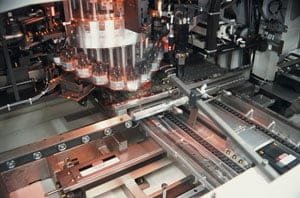
In providing an overview of the workings of the economy, this case study focuses on the key role of HM Treasury in implementing Government economic policies.It focuses on:
- How the Government deals with macroeconomic issues such as economic growth, employment and inflation. These issues are about the economy as a whole.
- How the Government deals with microeconomic issues such as the performance of businesses and their products within markets across the UK.
This also has a bearing on the productivity of this economy as a whole, and Britain’s competitiveness abroad. Managing the economy involves both macro and micro economic policy.
Economic events impact daily upon the lives of individuals and business organisations. We have only to pick up a newspaper or listen to the radio to hear about changes in living standards, or job opportunities for people who either want employment or wish to change from one job to another. Some stories might focus on changes in productivity, or prices of certain products such as cars, or even prices as a whole.
Others may refer to changes in the exchange rate, or new initiatives that have been undertaken to improve the environment in which we live. And, of course, public spending is always newsworthy, as is anything that has an effect on standards that are important to us, such as those in education, health and social welfare or safety within our society.
The economy
Business organisations are particularly affected by events within the economy. It is therefore important for the Government to create the stable macroeconomic environment that encourages people in business to invest, to employ more people and create demand for their products. In contrast when business people are uncertain about the future they are wary about investing and taking on new workers. The Government, through its microeconomic policies, is also encouraging businesses to increase productivity – that is to improve the amount of economic output they create from each worker and each pound of investment.
The economy comprises of many millions of households and businesses, as well as central and local government departments. The private sector is the part of the economy owned by private citizens, while the public sector is the part of the economy that is government owned and controlled. The UK is a mixed economy in which the private sector and the government work together in making decisions and solving economic problems. These decisions determine the total spending within the economy, as well as its total income and level of goods and services.

There is a link between producers and consumers in the economy. One way of looking at this is as a simple circular flow. For example, an imaginary household may receive all of its income in a month in the form of wages. If that household was to spend all of its income on consumer goods, there would be a flow of income from the producer or firm paying the wages back to the organisations through the mechanism known as the market.
The market
The market is the vital link between producers and consumers of goods and services. In some instances, producers and consumers may meet physically, such as at a local fruit stall in a market, but in most instances business is transacted through some form of intermediary such as a retail organisation.
The market is, therefore, the process by which decisions consumers make about the goods available to them and producers make about what to produce, are reconciled by the adjustment of prices. Prices of goods and of resources, such as wages for labour, ensure resources are used to produce the goods and services that society demands.
Government strategy

The Government’s central economic objective is to achieve high and stable levels of growth and employment that will build a stronger economic future for Britain. We live in an environment in which a range of forces constantly impacts upon organisations and their activities. On coming into office, the Government introduced a new framework for monetary and fiscal policy designed to promote economic stability and so create the conditions to meet its central objective.
In the UK, in working with both public and private sector, the key elements of the Government’s strategy are:
- locking in economic stability as a platform for long-term sustainable economic growth
- raising productivity through promoting enterprise and investment
- increasing employment opportunity, building a fairer society.
Means of influence
In order to meet its central economic objective, high and stable levels of growth and employment, the Government has a number of means of influence, both macro and microeconomic:
- Monetary policy, which is concerned with the money supply, rates of interest, exchange rates and credit. It is at the heart of this Government’s policy for stability. One of the Government’s first steps after the election was to make the Bank of England independent, ensuring that interest rate decisions are taken in the best long term interests of the economy and not for short term political considerations
- Fiscal policy, which is concerned with ensuring that Government borrowing – the difference between what the government spends and what it raises in tax revenue – is sustainable. This Government has introduced a Code for Fiscal Stability with strict rules to govern the public finances
- Through its tax raising and expenditure roles it has instruments to meet economic objectives. For example, the New Deal will help increase employability by giving those out of work new opportunities
- It can act directly through regulation and deregulation – the Government can and does propose new laws and amendments to old ones but it is important to remember that it is Parliament that actually makes laws. Regulation creates a framework in which organisations can operate and activities take place. Deregulation occurs when the Government removes some of the controls and restrictions in order to allow economic agents greater freedom of action
- Control of monopoly – United Kingdom competition law is made up of a number of Acts of Parliament, dealing with separate aspects of competition policy and consumer protection
- Public ownership and privatisation – the Government influences the market through its policies of public ownership and privatisation. For example, during the Second World War large sections of industry were taken over in order to co-ordinate production to meet the war effort. More recently, governments have relinquished control of some major industries including transport, gas, electricity and water, by selling shares in the companies.
Government aims and objectives

Economic stability is essential for long-term growth and high levels of employment. The person responsible for running the nation’s economy to meet this objective is the Chancellor of the Exchequer. The UK Government Departments responsible for executing taxation and spending policies that come directly under the responsibility of the Chancellor are HM Treasury, Inland Revenue and Customs and Excise.
The Chancellor of the Exchequer sets the aim and objectives of HM Treasury:
Aim – To raise the rate of sustainable growth and achieve rising prosperity through creating economic opportunities for all.
Objectives
- Maintaining a stable macroeconomic framework with low inflation
- Maintaining sound public finances in accordance with the Code for Fiscal Stability
- Improving the quality and cost effectiveness of public services
- Increasing the productivity of the economy and expanding economic and employment opportunities for all, through productive investment, competition, innovation, enterprise, better regulation and increased employability
- Promoting a fair and efficient tax and benefit system with incentives to work, save and invest maintaining an effective accounting and budgetary framework and promoting high standards of regularity, propriety and accountability
- Securing an efficient market in financial services and banking with fair and effective supervision
- Arranging for cost effective management of the government’s debt and foreign currency reserves and the supply of notes and coins
- Promoting international financial stability and the UK’s economic interests and ideas through international co-operation as a way of increasing global prosperity including seeking to protect the most vulnerable groups.
In the complex and interdependent world of Government, where a single decision may have widespread ramifications, HM Treasury’s work involves co-operation with a number of organisations and Government Departments that enables it to assist the Government in a variety of ways. These include:
- Government departments such as the Department of Trade and Industry (DTI), which carries out the Government’s policies on the industrial base of the nation in areas such as overseas trade and competition policy, promotion of new businesses and international competitiveness
- The Bank of England, the UK’s central bank works closely with HM Treasury and has responsibility for the issue of English bank-notes, as well as for implementing monetary policy, including interest rates
- Tax collecting bodies such as the Inland Revenue and Customs and Excise
- The Royal Mint, which manufactures and distributes all of the coins required to meet public demand
- Debt Management Office, which raises finance by issuing Government bonds in the wholesale market
- National Savings, which raises cost effective finance for the Government from the retail sector
- Office for National Statistics.
Macroeconomics

Macroeconomics is concerned with the economy as a whole – not details of individual industries or products – regarding key issues such as:
- inflation – percentage increase per annum in the price of goods and services
- output and growth – measures the total income of the economy in goods and services
- investment – doing without consumption today in order to generate future returns
- employment – changes in the labour market.
In the past, Britain suffered from greater variations in output and inflation than many other industrial countries. Low and stable inflation is important for creating the right conditions for business confidence which creates jobs within the economy and promotes investment and trade. Businesses also value transparency which is the key to developing their confidence. Macroeconomic stability is good for individuals as well as business because it increases confidence and prevents boom and bust.
A framework has been introduced to promote economic stability, which ensures that macroeconomic policy responds sensibly to economic shocks. This includes:
- a monetary framework to deliver low and stable inflation that allows the Bank of England’s Monetary Policy Committee the independence to set interest rates to deliver the Government’s inflation target
- a fiscal framework with strict fiscal rules that retains tight control over government finances
- a public expenditure regime with three-year spending plans to provide greater certainty and encourage longer-term planning.
Microeconomics

Microeconomics is concerned with the treatment of specific individual markets, products and types of organisations. Business people support Government policies that support the actions of individual business organisations and encourage them to be more efficient and compete more effectively.
In recent years many measures known as ‘supply-side’ economics have been introduced, designed to help organisations to compete more efficiently and raise their productivity. For example, the Government has recently introduced the following incentive tools:
- A new 10p corporation tax rate for small companies
- A £20 million venture capital challenge to finance early stage high technology businesses
- A new Research and Development tax credit to encourage small business investment in R&D
- Discounts for training courses such as computer literacy.
The budget
A key area of the role of HM Treasury is in advising the Chancellor of the Exchequer on the Government’s forward financial plan, which is known as the Budget. This sets out the Government’s income and expenditure plans. Income is raised through direct and indirect taxes levied upon firms and individuals and then spent upon goods and services such as health, education, transport and defence.
Budget 99 was used to meet the economic objective of high and stable levels of growth and employment. Through the creation of incentives, it encouraged a better deal for enterprise and investment as well as the creation of economic stability as a platform for sustainable growth.
Conclusion

This case study has provided a broad overview of the workings of the UK economy. Economic growth, fairness and opportunity go hand-in-hand. An economy in which a significant proportion of the population is unable to fulfil its potential will be poorer and less productive.
HM Treasury assists the Chancellor of the Exchequer in developing an economic strategy which enables the Government to meet its key economic objective and provide a better climate for British business which means a better life for individuals within the UK and build a stronger economic future for Britain.
